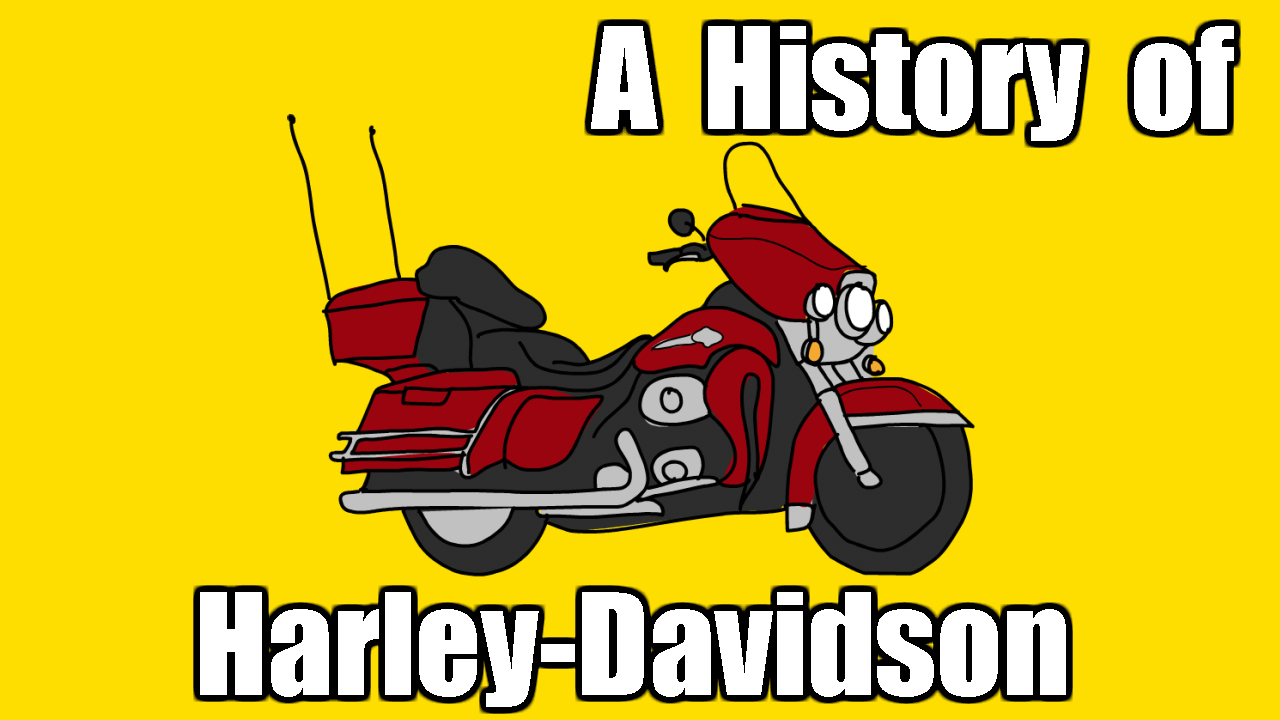In 1901, 20-year-old William S. Harley designed a small engine to be used on a bicycle. He and his childhood friend, Arthur Davidson, worked on the motor for two years until in 1903 they completed it with the help of Arthur’s brother, Walter. It reached a speed of 6mph but when going up hills still required pedal power. They immediately got to work on an improved version and built their first entire motorbike with the help of Arthur’s eldest brother, William A. Davidson, who was a tool room foreman. The motorcycle entered its first race in 1904 and they built seven more motorbikes that year. In 1905 they began advertising their Harley-Davidson engines for sale and made 16 bikes over the course of the year. By 1906 production was close to one bike a week.
The following year William S. Harley earned a degree in Mechanical Engineering. The company produced 150 bikes and made their first sale to a police department. At the time, they were still well behind Triumph — the British motorcycle company who sold 1000 bikes during the same period.
Production steadily increased (In 1908–450 bikes, in 1909–1149 bikes) and in 1910 Harley-Davidson’s famous logo was created (“Bar and Shield”). In 1913 production increased yet further (16,284) after a move to a new five floor building, still in Milwaukee, Wisconsin.
Arthur Davidson spoke to government officials and convinced them to replace their bicycles for the postal service with motorbikes. By 1914 there were 4,800 motorbikes used to deliver mail across the United States. The military also liked the motorbikes and Harley-Davidson sales rocketed.
In 1917, Harley bicycles were unveiled. Over the next couple of years Harley-Davidson provided over 20,000 machines to the American armed forces to support them in the First World War. Seventeen years after the company was founded, in 1920 Harley-Davidson became the largest motorcycle manufacturer in the world (28,189).
The first motorcycle to win a race with an average speed of over 100mph was a Harley in 1921 and Harley riders won all the National Championship races the following year.
The Wall Street crash and the subsequent depression that hit America meant that sales began to fall. They sold under 4,000 motorcycles for the year in 1933. A year before the Great Depression, the Harley-Davidson brand name was stitched into a leather jacket. This diversification of products helped them become one of only two US motorbike manufacturers to survive the depression and merchandise is now the third biggest seller for them, behind motorcycles and parts and accessories. The Second World War saw Harley-Davidson produce motorcycles for the army once more.
In the early 1940s, two of the founders passed away (1942 — Walter Davidson, 1943 — William S. Harley). The end of the Second World War saw production resume for the civilian population. In 1949 the naming convention changed so that bikes were given names (beginning with the Hydra-Glide) rather than initials and numbers. The year also sees the establishment of the Harley-Davidson riders club in Great Britain.
At the age of 69, Arthur Davidson died at the start of the 50s. This decade also saw the beginning of motorbike manufacturing by Japanese companies (Suzuki ’52, Kawasaki ’54 and Yamaha ’55) which would become rivals in the coming years. Yamaha became the first Japanese motorbikes to be sold in America in 1959.
The 1960s saw a period of substantial change for Harley-Davidson. Firstly, they began investing in other companies (They bought 50% of Aeronautica Macchi’s motorcycle arm in 1960 and bought a glass fibre company in 1963). Secondly, in 1965 after 60 years as a privately owned company, Harley-Davidson went public. By 1969, the company was bought by AMF. Significant redundancies to workers occurred soon after, causing strikes, and lower quality bike production saw many customers abandon Harley in favour of imported Japanese bikes.
In the mid-70s, Harley bought out Aermacchi completely (1974) and its bike production topped 75,000 per year (In 1975–75,403 bikes). On the 75th anniversary of the company in 1978, new Harley models are introduced and Aermacchi is sold off.
In 1981, 13 investors including William G. Davidson the grandson of the co-founder, bought Harley-Davidson back from AMF for $80million. A couple of years later (in 1983) an import tariff of 45% was introduced by President Ronald Reagan on imported bikes over 700cc. Harley-Davidson focused on bikes that had a “retro” look. This coupled with an increase in the quality of components appealed to buyers who slowly returned to company. In 1987 Harley-Davidson went public again and was listed on the New York stock exchange.
A new model called “Fat Boy” was launched in 1990 and helped Harley lead sales in the over 750cc market. On the 90th anniversary (1993) a celebratory event called “Ride Home” was introduced, which involves enthusiasts riding to Milwaukee. It has been repeated every five years and attracts riders from all over the world. The end of the decade (1999) sees Harley-Davidson producing its largest engine to date (1450cc) and Ford launches a Harley-Davidson pickup truck.
In 2004, Harley-Davidson shares drop by a third from $60 down to $40 following claims of inflated sales figures. In 2006 Harley announced its first Chinese dealership. At the start of the following year shares rose back up to $70. The Harley-Davidson museum opened in 2008 and Harley expanded into India and started operations there in 2009. The financial crisis lead to reduced revenue that year but despite the closure of factories and the reduction in the workforce, Harley survived, recovered and to this day continues to provide extraordinary motorcycles to its customers.
From an initial vision to try to take the work out of cycling, the Harley-Davidson motorbike is now an iconic brand, recognised around the world. It has survived turmoil such as the Great Depression, buyouts and strikes and continues to be successful, over a century on from its humble beginnings.

